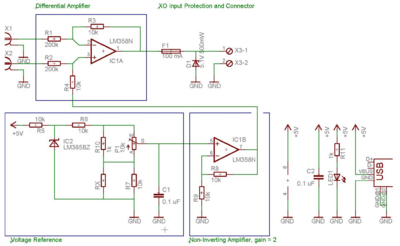Measure/Blog: Difference between revisions
No edit summary |
|||
| Line 4: | Line 4: | ||
Some of my ideas, thoughts, back-of-an-envelope sketches and musings regarding hardware interfaces to Measure: |
Some of my ideas, thoughts, back-of-an-envelope sketches and musings regarding hardware interfaces to Measure: |
||
[[Image:DiffAmpInterface.PNG|thumb|400px|[[Media:PDiffAmpInterface.PNG|actual size]]|center|A redrawn schematic of the differential amplifier interface as shown on [[Measure/Projects]]]] |
[[Image:DiffAmpInterface.PNG|thumb|400px|[[Media:PDiffAmpInterface.PNG|actual size]]|center|A redrawn schematic of the differential amplifier interface as shown on [[Measure/Projects]] - it should be a bit clearer and easier to follow its electronic operation.]] |
||
I've added a fuse and 5.1V Zener diode on the XO input, as you can see - this should, hopefully, be suitable for making these types of electronic interfaces for Measure robust and "noobie-proof". |
I've added a fuse and 5.1V Zener diode on the XO input, as you can see - this should, hopefully, be suitable for making these types of electronic interfaces for Measure robust and "noobie-proof". |
||
| Line 18: | Line 18: | ||
== Project ideas == |
== Project ideas == |
||
Measuring daily changes in solar irradiance: |
=== Measuring daily changes in solar irradiance: === |
||
Use a suitable interface, such as this, to measure the DC voltage from a photovoltaic module, and log how it changes over a period of a day - I'm sure we could even use the OLPC photovoltaic charging module for this - it has a 12V DC output - just make sure your amplifier/buffer interface will be suitable for that! |
Use a suitable interface, such as this, to measure the DC voltage from a photovoltaic module, and log how it changes over a period of a day - I'm sure we could even use the OLPC photovoltaic charging module for this - it has a 12V DC output - just make sure your amplifier/buffer interface will be suitable for that! |
||
Optical barrier alarm: |
=== Optical barrier alarm: === |
||
Turn on the voltage bias, and connect a LDR. Say our LDR has 500k dark resistance and max 2800 ohms in light. (That was measured from a mystery one in my junk box.) Given 785 mV bias with 790 ohms effective impedence, we have then, 784 mV dark input voltage, and 612 mV light input voltage - quite detectable discrete levels. |
Turn on the voltage bias, and connect a LDR. Say our LDR has 500k dark resistance and max 2800 ohms in light. (That was measured from a mystery one in my junk box.) Given 785 mV bias with 790 ohms effective impedence, we have then, 784 mV dark input voltage, and 612 mV light input voltage - quite detectable discrete levels. |
||
| Line 28: | Line 28: | ||
1 mW 660nm red laser diode modules are cheap and easily accessible for experimenters - but remember, if working with children or young people, teaching prudent laser safety is a good idea, even at this power level. |
1 mW 660nm red laser diode modules are cheap and easily accessible for experimenters - but remember, if working with children or young people, teaching prudent laser safety is a good idea, even at this power level. |
||
Temperature acquisition: |
=== Temperature acquisition: === |
||
Using the simple LM335 probe, described in detail at [[Measure]], a simple classroom demonstration of Newton's Law of Cooling can be realised, using the computer as a datalogger. |
Using the simple LM335 probe, described in detail at [[Measure]], a simple classroom demonstration of Newton's Law of Cooling can be realised, using the computer as a datalogger. |
||
Revision as of 15:58, 29 January 2008
(be sure to include as many pictures as you can)
Some of my ideas, thoughts, back-of-an-envelope sketches and musings regarding hardware interfaces to Measure:

I've added a fuse and 5.1V Zener diode on the XO input, as you can see - this should, hopefully, be suitable for making these types of electronic interfaces for Measure robust and "noobie-proof".
This is all my half-baked, untested, back-of-an-envelope stuff - no promises it works! Peer review, comments, feedback, or criticisms are all welcome.
I don't claim all these ideas as unique or new - but I'm trying to take existing project ideas from the projects page and flesh them out a little more.
I don't have access to an XO-1 machine - if any developers who do might like to test my ideas, as they mature, I'd love to hear the results!
Project ideas
Measuring daily changes in solar irradiance:
Use a suitable interface, such as this, to measure the DC voltage from a photovoltaic module, and log how it changes over a period of a day - I'm sure we could even use the OLPC photovoltaic charging module for this - it has a 12V DC output - just make sure your amplifier/buffer interface will be suitable for that!
Optical barrier alarm:
Turn on the voltage bias, and connect a LDR. Say our LDR has 500k dark resistance and max 2800 ohms in light. (That was measured from a mystery one in my junk box.) Given 785 mV bias with 790 ohms effective impedence, we have then, 784 mV dark input voltage, and 612 mV light input voltage - quite detectable discrete levels.
1 mW 660nm red laser diode modules are cheap and easily accessible for experimenters - but remember, if working with children or young people, teaching prudent laser safety is a good idea, even at this power level.
Temperature acquisition:
Using the simple LM335 probe, described in detail at Measure, a simple classroom demonstration of Newton's Law of Cooling can be realised, using the computer as a datalogger.
